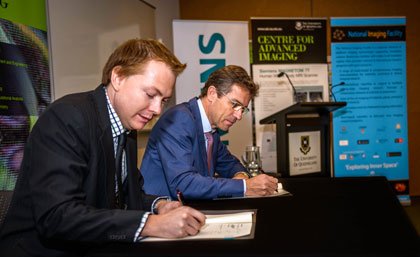
A collaboration agreement between The University of Queensland and Siemens Australia will boost research and development in Magnetic Resonance Imaging (MRI), leading to better diagnosis and treatment of degenerative diseases.
The agreement was signed in a ceremony today (27 June) by UQ Vice-Chancellor Professor Peter Høj and Toby Carrington, Vice President Finance for Siemens Healthcare in Australia and New Zealand.
Professor Høj said the agreement strengthened the relationship between UQ and Siemens Australia, and demonstrated how research could be enhanced through collaboration, leading to results that benefited society.
“UQ has a strong track record in magnetic resonance research, with most of the MRI scanners in the world using technology developed by UQ’s Professor Stuart Crozier,” Professor Høj said.
“This collaboration with Siemens, a globally operating technology company and a world leader in magnetic resonance, is a perfect fit with UQ’s strength in this area.”
Professor Høj said the agreement focused specifically on research enabled by the powerful Siemens MAGNETOM 7 Tesla (7T) scanner, the first 7T whole-body MRI scanner in the Southern Hemisphere, which was installed at UQ’s Centre for Advanced Imaging this year.
Funded by the Federal Government’s Education investment Fund initiative, the prestige MRI scanner is also a flagship imaging capability for the National Imaging Facility UQ node, which is located at CAI.
“The addition of the 7T scanner, along with the recent installation of Siemens scanners at the Herston Imaging Research Facility, enhances UQ’s capacity to be a global leader in imaging research,” Professor Høj said.
Mr Carrington said his company was proud to be part of this strong and long-term collaborative partnership centred around high-end research technology.
“What’s really exciting about this collaboration isn’t so much the technology, but the application of this technology by Australian researchers who now have an extraordinary new weapon in their arsenal to better understand and ultimately fightdiseases and their progression,” said Mr Carrington.
“One thing we realised very early on is that technology can’t reach its full potential inside a Siemens factory. To really advance human health we need partnerships like this where the best technology is combined with Australia’s brightest research minds.”
“We are extremely proud to be part of this exciting venture and, we are looking forward to exploring new frontiers of medical research with the UQ.
“The new collaboration agreement is the foundation of a common goal to exploit the full potential and benefits of whole-body 7Tesla MRI. The research program will help find answers to world’s most challenging healthcare questions.
“The research work done here will show a new level of leadership and inspiration in adapting to next-generation technology that is needed to unlock new healthcare discoveries.
“By partnering with the UQ, we help define new standards-of-care in order to advance human health.”
Leading Ultra High Field MRI researcher Associate Professor Markus Barth has moved to UQ from the Donders Institute for Brain, Cognition and Behaviour in The Netherlands to work with the new scanner. As the NIF Facility Fellow for the 7T system, Associate Professor Barth will be supporting researchers across Australia.
“The research agreement is a great opportunity to translate top research done by the researchers at the Centre for Advanced Imaging into clinical and research applications for improved diagnostics of Alzheimer’s disease, Parkinson’s disease, multiple sclerosis and epilepsy, as well as joint degeneration and injury,” Associate Professor Barth said.
MEDIA: Centre for Advanced Imaging, Rebecca Osborne, +61 7 3365 4235, rebecca.osborne@cai.uq.edu.au; Siemens Ltd Media Relations Keith Ritchie, +61 457 841 189, keith.ritchie@siemens.com .
About the Centre for Advanced Imaging: The centre was created in 2009 as a strategic initiative of The University of Queensland. It reflects the growing role of imaging in cutting-edge biotechnology and biomedical research at UQ. Bringing together the skills of a critical mass of researchers and state-of-the-art research imaging instruments, it is the only facility of its type in Australia, and one of only a handful of such centres in the world. The Centre for Advanced Imaging also hosts the largest node for National Imaging Facility, which is an Australian government initiative that connects state-of-art imaging capabilities across all mainland states in Australia.
About Siemens: Siemens commenced operations in Australia in 1872 and in New Zealand in 1876. Siemens is recognised as of one of the most reliable and trusted brands in the region. With well-established businesses in both Australia and New Zealand, Siemens is a diversified technology-based solutions provider specialising in the areas of Energy, Healthcare, Industry and Infrastructure and Cities. At the end of fiscal 2013 (September 2013), Siemens interests in Australia and New Zealand achieved approximately AUD $1.9 billion in sales with over 2700 employees. Globally at the end of fiscal year 2013, revenue from the Environment Portfolio totalled EUR 32.3 billion, making Siemens the world’s largest supplier of ecofriendly technologies. In the same period, the company’s products and solutions enabled their customers to reduce CO 2 emissions by 377 megatons. This amount is equal to approximately 70 percent of Australia’s annual CO 2 emissions. Further information is here.
.jpg)










